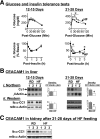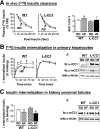Forced Hepatic Overexpression of CEACAM1 Curtails Diet-Induced Insulin Resistance
- PMID: 25972571
- PMCID: PMC4512217
- DOI: 10.2337/db14-1772
Forced Hepatic Overexpression of CEACAM1 Curtails Diet-Induced Insulin Resistance
Abstract
Carcinoembryonic antigen-related cell adhesion molecule 1 (CEACAM1) regulates insulin sensitivity by promoting hepatic insulin clearance. Liver-specific inactivation or global null-mutation of Ceacam1 impairs hepatic insulin extraction to cause chronic hyperinsulinemia, resulting in insulin resistance and visceral obesity. In this study we investigated whether diet-induced insulin resistance implicates changes in hepatic CEACAM1. We report that feeding C57/BL6J mice a high-fat diet reduced hepatic CEACAM1 levels by >50% beginning at 21 days, causing hyperinsulinemia, insulin resistance, and elevation in hepatic triacylglycerol content. Conversely, liver-specific inducible CEACAM1 expression prevented hyperinsulinemia and markedly limited insulin resistance and hepatic lipid accumulation that were induced by prolonged high-fat intake. This was partly mediated by increased hepatic β-fatty acid oxidation and energy expenditure. The data demonstrate that the high-fat diet reduced hepatic CEACAM1 expression and that overexpressing CEACAM1 in liver curtailed diet-induced metabolic abnormalities by protecting hepatic insulin clearance.
© 2015 by the American Diabetes Association. Readers may use this article as long as the work is properly cited, the use is educational and not for profit, and the work is not altered.
Figures






Similar articles
-
CEACAM1 regulates insulin clearance in liver.Nat Genet. 2002 Mar;30(3):270-6. doi: 10.1038/ng840. Epub 2002 Feb 19. Nat Genet. 2002. PMID: 11850617
-
Loss of CEACAM1 in hepatocytes causes hepatic fibrosis.Eur J Clin Invest. 2024 Jul;54(7):e14177. doi: 10.1111/eci.14177. Epub 2024 Feb 21. Eur J Clin Invest. 2024. PMID: 38381498 Free PMC article.
-
Liver-specific reconstitution of CEACAM1 reverses the metabolic abnormalities caused by its global deletion in male mice.Diabetologia. 2017 Dec;60(12):2463-2474. doi: 10.1007/s00125-017-4432-y. Epub 2017 Sep 14. Diabetologia. 2017. PMID: 28913658 Free PMC article.
-
Loss of Hepatic CEACAM1: A Unifying Mechanism Linking Insulin Resistance to Obesity and Non-Alcoholic Fatty Liver Disease.Front Endocrinol (Lausanne). 2017 Jan 26;8:8. doi: 10.3389/fendo.2017.00008. eCollection 2017. Front Endocrinol (Lausanne). 2017. PMID: 28184213 Free PMC article. Review.
-
CEACAM1 in Liver Injury, Metabolic and Immune Regulation.Int J Mol Sci. 2018 Oct 11;19(10):3110. doi: 10.3390/ijms19103110. Int J Mol Sci. 2018. PMID: 30314283 Free PMC article. Review.
Cited by
-
In vivo techniques for assessment of insulin sensitivity and glucose metabolism.J Endocrinol. 2024 Jan 31;260(3):e230308. doi: 10.1530/JOE-23-0308. Print 2024 Mar 1. J Endocrinol. 2024. PMID: 38198372 Free PMC article. Review.
-
Leptin Resistance Contributes to Obesity in Mice with Null Mutation of Carcinoembryonic Antigen-related Cell Adhesion Molecule 1.J Biol Chem. 2016 May 20;291(21):11124-32. doi: 10.1074/jbc.M116.716431. Epub 2016 Mar 21. J Biol Chem. 2016. PMID: 27002145 Free PMC article.
-
Age-dependent insulin resistance in male mice with null deletion of the carcinoembryonic antigen-related cell adhesion molecule 2 gene.Diabetologia. 2017 Sep;60(9):1751-1760. doi: 10.1007/s00125-017-4307-2. Epub 2017 May 31. Diabetologia. 2017. PMID: 28567513 Free PMC article.
-
Reduced Hepatic Carcinoembryonic Antigen-Related Cell Adhesion Molecule 1 Level in Obesity.Front Endocrinol (Lausanne). 2017 Mar 27;8:54. doi: 10.3389/fendo.2017.00054. eCollection 2017. Front Endocrinol (Lausanne). 2017. PMID: 28396653 Free PMC article.
-
High-fat diet amplifies renal renin angiotensin system expression, blood pressure elevation, and renal dysfunction caused by Ceacam1 null deletion.Am J Physiol Endocrinol Metab. 2015 Nov 1;309(9):E802-10. doi: 10.1152/ajpendo.00158.2015. Epub 2015 Sep 15. Am J Physiol Endocrinol Metab. 2015. PMID: 26374765 Free PMC article.
References
-
- Svedberg J, Björntorp P, Smith U, Lönnroth P. Free-fatty acid inhibition of insulin binding, degradation, and action in isolated rat hepatocytes. Diabetes 1990;39:570–574 - PubMed
-
- Osborne TF. Sterol regulatory element-binding proteins (SREBPs): key regulators of nutritional homeostasis and insulin action. J Biol Chem 2000;275:32379–32382 - PubMed
Publication types
MeSH terms
Substances
Grants and funding
- R01 DK083850/DK/NIDDK NIH HHS/United States
- U24-DK-093000/DK/NIDDK NIH HHS/United States
- R01 HL112248/HL/NHLBI NIH HHS/United States
- R01-DK-054254/DK/NIDDK NIH HHS/United States
- R01-DK-67536/DK/NIDDK NIH HHS/United States
- R01-DK-083850/DK/NIDDK NIH HHS/United States
- R01 DK054254/DK/NIDDK NIH HHS/United States
- U24 DK093000/DK/NIDDK NIH HHS/United States
- R01 DK067536/DK/NIDDK NIH HHS/United States
- R01 DK103215/DK/NIDDK NIH HHS/United States
- R01-DK-103215/DK/NIDDK NIH HHS/United States
- R01-HL-112248/HL/NHLBI NIH HHS/United States
LinkOut - more resources
Full Text Sources
Other Literature Sources
Molecular Biology Databases
Miscellaneous

